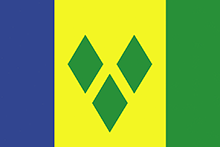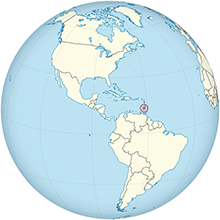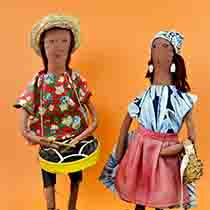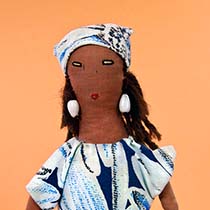Description of Figure/Doll
Dolls of a man and woman from Grenadines of St. Vincent. They are made of cloth over wire. He is playing a steel drum and she is carrying a basket. They are dressed in bright prints, he’s wearing a straw hat and shorts; she’s wearing a dress, scarf and apron. A ribbon on the hat and basket says “St. Vincent W.I.” Tag: “The Grenadines of St. Vincent 1983”.
Link to higher resolution images at ClipPix
St. Vincent and the Grenadines
Location: Caribbean Island
Capital: Kingstown
Main language: English
Currency: East Caribbean dollar
Figure/Doll
Construction: cloth, wire, straw
Height in Centimeters: 25
Height in Inches: 10


A Volcano Named La Soufriere
Reading Level: 5.10
My name is Pilar and I live in a small village north of Georgetown, on the island of St Vincent. St. Vincent is the largest island in the chain of Caribbean islands called “St. Vincent and the Grenadines”. We are Caribs, which means we were some of the original settlers. My family, like many of the residents of St. Vincent, is very poor.
When I was twelve years old, an event happened that I will never forget. In the center of our island is a volcano called La Soufrier. It is the highest peak on St Vincent. For the past 90 years, this volcano did not show signs of much activity. In fact, it was a great place for scenic views.
On May 7, 1902, I was working in the sugar fields with my dad when we felt the earth shake. The lightning and thunder were terrific, and at first we thought it was a storm. However, as I looked towards the mountains, I could see a column of steam and dust in the sky. At the same time a discharge of poisonous vapor spewed from the opening of the volcano. Rocks started to fall. Dad yelled that I should follow him. We ran towards the manager’s building. Quickly, we crowded into the small office with about 70 other men and boys, and shut the windows and doors as tight as possible.
We cringed in the room as the giant mass of intense smoke and the red hot ash swept past. It burned and suffocated everything in its path. The heat in the building was terrible, but at least we had some protection.
When the dark clouds passed, we slowly walked back outside. The devastation was terrifying. Anyone who had not made it to a shelter was dead (from poisonous gasses or the heat). In addition, all of the cattle, horses, and mules had either suffocated or been struck by lightning.
Luckily, the rest of my family was in Georgetown that day. By some miracle, Georgetown escaped the worst of the eruption. The island of St. Vincent now looked like a desert covered with grey sand. It would be a long time before we were needed in the sugar fields again.
After that fateful day, we realized that the volcano that towers over our island could always be a threat. In fact, La Soufrier erupted again 77 years later (1979). Who knows when the next disaster might strike our tropical paradise?





